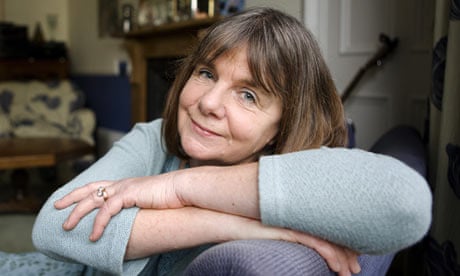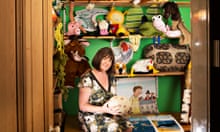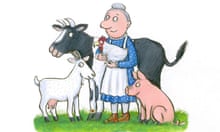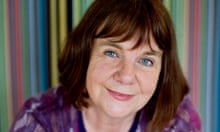When he was working on the illustrations for Julia Donaldson's The Snail and the Whale, a few years after their hugely successful picture book The Gruffalo, Axel Scheffler had the idea that one of the children on the beach in the story could be drawing a gruffalo in the sand. Since then, Donaldson-Scheffler fans have been able to play a game of spot the gruffalo: in each of their books, somewhere in one of the pictures lurks their distinctive brown monster – disguised as a fish, a Christmas decoration, a cuddly toy. "At the beginning it was quite a naff idea, I thought," Scheffler says, "but I'll have to carry on now because children have started looking for it."
The Gruffalo celebrated its 10th birthday this year. On Christmas Day a new 30-minute animation will be screened on BBC1, featuring the voices of Helena Bonham Carter and Tom Wilkinson. More than 4m copies have been sold (Donaldson's total sales have topped 14m), a stage show is in the West End, Gruffalo merchandise is in the shops, and last month Radio 2 listeners voted it the nation's favourite bedtime story, ahead of Winnie-the-Pooh. The book has become a classic.
The details of how it came to be are becoming the stuff of publishing legend: how Donaldson had the idea years ago, when she was a jobbing author of educational books, but kept it to herself; how originally the story, derived from a Chinese folk tale, was going to be about a tiger, only tiger wouldn't rhyme; how the 700-word text sat on a publisher's desk for a year before Donaldson, out of frustration, sent it to Scheffler, a German illustrator with whom she had worked years earlier. As for the monster himself, with his terrible teeth and terrible claws, the story goes that she wrote the line "Silly old fox, doesn't he know, there's no such thing as a . . ." before the word "gruffalo" popped into her head. When we flick through the book together in the kitchen of her home in Glasgow, I say how clever it is when the mouse says "Didn't you know, there's no such thing as a Gruffal-" and you turn the page to see the gruffalo for the first time, and the mouse says "OH!". "That was why he was called the Gruffalo," Donaldson explains and then corrects herself. "No, perhaps he was just the Gruffalo to rhyme with 'doesn't he know."
Donaldson was 51 when The Gruffalo was published. Since then her work rate has been phenomenal. She has published more than 20 books, about half of them with Scheffler. This year she brought out her first teenage novel, Running on the Cracks, as well as Tabby McTat with Scheffler, What the Ladybird Heard with Lydia Monks and The Troll with David Roberts. At any one time she has several works in progress: currently Scheffler is working on Zog, a dragon story, there's her first book with the award-winning illustrator Emily Gravett, and she is thinking about who might illustrate a sequel she has written to Edward Lear's "The Owl and the Pussycat": "At times I've had quite grandiose ideas and approached some very grand illustrators who've very nicely said no."
Meanwhile she has a busy sideline in putting on performances of her stories at schools and festivals with assorted family members. On shelves up to the ceiling in her "prop room", off the kitchen, are carefully labelled boxes full of puppets, many of them made by Laura Burr, a craft enthusiast in her publisher's marketing department. She demonstrates the rabbit from The Troll, trip-trapping over the bridge with a Californian accent – "good though he is, his mouth doesn't open quite as wide as it could do" – but says her husband Malcolm gets the best parts: "I'm always the narrator or something, but he moans that he always has to be bad or stupid or both.'
As a child, growing up in an arty, leftwing Hampstead household with her parents, younger sister Mary, aunt, uncle and grandmother, she wanted to act. "I think those girlhood ambitions are tied up with a sort of romanticism. I genuinely loved acting and I did have some sort of talent, but after I understudied for the fairies in A Midsummer Night's Dream when I was about 12, I often used to go to the Old Vic and sit up in the gods and I'd imagine almost flying down on to the stage. It was, I have to admit – not in a really horrible way – this thing of, no one realises, but I am just wonderful."
She and her sister were great friends. "I think she sort of hero-worshipped me, and I used to pretend I was – well, I think I believed I was – a fairy in disguise. We had bunk beds and we had this furry dog with a burnt nose called Maflinda, and I would make her do shows, and my father would be playing [string] quartets next door. So I would dangle Maflinda down from the top bunk and she would dance. And then I did this thing of being the witch who never got there and I sort of swung the light and it made this wonderful shadow on the wall and my sister really didn't know how it was done."
Donaldson studied drama and French at Bristol university, where she met Malcolm, a medical student. They travelled around Europe, busking, and she began writing down her songs. She sent a tape to the BBC "and that led to a very on and off, up and down sort of career writing songs for children's television". She also wrote two musicals and an operetta telling the story of their romance, which they performed at their wedding reception.
Donaldson was 29 when Hamish, the first of three sons, was born. In the 1980s she helped out at the children's school and began writing sketches for her reading group. She kept these "playlets" in a drawer but wasn't confident enough to contact a publisher until, in 1990, Methuen called her with the idea of making one of her songs, "A Squash and a Squeeze", into a picture book. She began working for educational publishers, writing "plays and retellings of folk tales and things".
Donaldson's would be such a happy story, of talent and hard work and well-deserved riches, were it not for one very great sadness. Her son Hamish grew from an imaginative but complicated child into a disturbed adolescent, finally being diagnosed with schizoaffective disorder. He suffered episodes of depression and psychosis and, in 2003, took his life, aged 25.
She mentions him often, along with his brothers Alastair and Jerry (originally called Jesse, "but that didn't go down well in Scotland" – he became Jerry after Julia's father). But her tears are close to the surface. When she became patron of the charity Artlink Central, which brings artists together with people with special needs, Donaldson spoke publicly about Hamish's illness, but she has grown weary of interviewers raking over painful private details. She says: "I think knowledge of mental health is in its infancy, we're in the stone age, so I can't really say it was this or that." But she believes her son was "born different", with some genetic predisposition to psychiatric illness. "I know some people wouldn't agree with that."
She believes that her career taking off as it did probably helped her to survive: "That thing of compartmentalising is very important. Especially if you've got something very difficult going on, the best way of coping is to have some other area of your life that's quite separate."
Donaldson's teenage novel Running on the Cracks tackles themes of mental illness. She says: "At the time probably the last thing I would have written was a story about what we were going through. But some of the things coming out now in my writing, maybe just subconsciously – I mean, in a way it's funny that Tiddler and Stick Man and Tabby McTat have all got that theme of someone getting lost and found, and maybe that is a bit about going through it somehow and recovering. Whereas the next one I've done with Axel is called Zog and it's much more lighthearted."
She says Tabby McTat is also "very much about handing on to the next generation. I think things do come out that are to do with the stage in life you're at, and what with the children being married and pregnant and things . . ." So she's expecting a grandchild? She sounds delighted: "I am, actually. I wasn't really allowed to say before."
Though she is careful not to criticise other writers directly, Donaldson has strong ideas about what children's books should and shouldn't do. She believes she had trouble getting published in the first place because the fashion then was for prose and sentiment. She spent ages trying to write something "modern", before one editor died and another one said "why don't I do something in rhyme, retelling a traditional tale, which was exactly what the other one had said not to do".
Although she has stopped looking for direct inspiration from folk tales and fables, their universal and mythic quality is what she aspires to recreate. The point of a story, whether for adults or children, is that it takes you away from your ordinary experience and on an adventure. Above all, it should have a good plot. "I don't like to generalise, because any book of its kind can be good or bad, and I think Guess How Much I Love You is quite a nice book, but around that time there did seem to be lots of books about a father or mother animal and their baby, and they'd be off together in the woods or something, and the baby would say [she puts on a soppy baby voice] 'will you catch me a . . .?' or 'will you still love me even if this or that?''' She answers wearily: "yes", and adds: "There's nothing wrong with that, but I can't help feeling that perhaps those sort of books are much nicer for the parent."
Nor does she like "preachy" books that carry too-obvious a moral message: "There seemed to be a lot of books as well, like, 'so-and-so was very shy [puts on a dreary voice], so at school no one wanted to play with her, she had all those problems, blah blah, she tried this, she tried that, she tried the other. Then one day someone said 'try smiling', so so-and-so went to school and gave a big smile and then suddenly everyone smiled back.
"And you think, well, a) it's not very likely, you know – probably the children will say 'you're all toothy' and it might not have the desired result. And b) it almost seems that those books are there so that if a parent has got a shy child they think 'oh great, I'll get this book, it will help'. That's what I mean by the picture-book medicine: if I read this book three times a day to her then she might go to school and smile and overcome all her own problems. I don't really think books should be like that."
One of Donaldson's favourite authors is the American Arnold Lobel. His book Mouse Soup could be viewed as a kind of inspiration for The Gruffalo as it too features a predator outwitted, albeit via different means, by a mouse. "I love, love Arnold Lobel. I wish he was better known here. He is like my god because in those frog and toad books he's so generous, so inventive. He manages to get about five cracking good ideas into one book and they're so funny, and our children would be in hoots of laughter every time Toad said 'blah'. It was too much. They wouldn't go to sleep because they were so full of mirth."
Donaldson's own humour is aimed at parents as well as children. But the playful comedy of her gorgeous rhythms and rhymes — "'I like Tiddler's story', said little Johnny Dory,/And he told it to his granny, who told it to a crab" – is interspersed with flashes of real fear. She thinks the gruffalo starts to look "more clown-like, more buffoon-like" as the book progresses, but wonders whether the BBC's animation has gone too far the other way: "I've acted it five billion times and obviously I know it completely by heart, but I found the snake and things quite scary."
She objects to politically correct censorship of children's literature: "It's easy to underestimate children, and I think it's much better that they have the whole range . . . It really used to annoy me when Philip Pullman said he hated the Narnia books because it was terrible to have this religious allegory, and I'd be thinking, well hold on, surely that's what's wonderful about books – that you enter into other people's minds and see there's all these different ways of looking at the world?" But she's always trying to come up with new female characters: "'I wanted the gruffalo's child [in the sequel story] to be a girl, and that probably was political correctness in a way, because I had been criticised for the fact that in The Gruffalo they were all male."
When Malcolm retires in a few years' time from his post as a paediatrician at Yorkhill children's hospital, they will resume their life as travelling players, maybe moving south, keeping their flat in Edinburgh so they can go back to Scotland for piano lessons. "I think barely a day has gone by in our married life when he hasn't headed for his guitar and played a song. And he's so supportive, not just being nice but genuinely – he gets back from work and he'll be all agog and say 'are there any good emails?' He once said his favourite job if he wasn't a doctor would be a helper in a playgroup."
And what of that other partnership, the most successful writer-illustrator collaboration for decades? "I would love to do a book for Axel about bugs because I love his little bugs, but I haven't managed to think of a good storyline." The idea for Stick Man, their book before last, came from Scheffler: he drew the gruffalo's child holding a stick doll. The image rooted in Donaldson's mind, and grew, nourished by memories: "I think most children, or boys anyway, love playing with sticks. Not just fighting, but Hamish in particular used to play with sticks when we were living in France. We didn't have very many toys because we'd gone without, and he just used to play with bits of cardboard and rubbish and say they were ice-creams or violins. It's that idea of an object that can become anything in someone's imagination."






